japanese
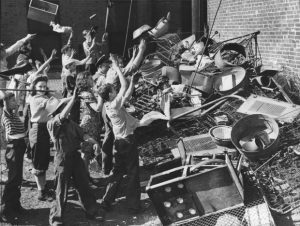 When the United States was pulled into World War II following the Japanese attack on Pearl Harbor. raw materials were in high demand globally, and hard to come by. Commodities such as rubber and cloth became precious and very valuable to the war effort. Many of the men were now off fighting the war, and so the factories, mines, etc. were not producing the necessary materials to build the much needed military equipment and weapons for the war effort.
When the United States was pulled into World War II following the Japanese attack on Pearl Harbor. raw materials were in high demand globally, and hard to come by. Commodities such as rubber and cloth became precious and very valuable to the war effort. Many of the men were now off fighting the war, and so the factories, mines, etc. were not producing the necessary materials to build the much needed military equipment and weapons for the war effort.
When it was decided that the country needed a drive to supply these materials, the Community-Minded Patriotism of the United States Home Front swung into action. The nation decided that they needed a drive to collect the materials needed. On Oct. 5, 1942, the first day of the first drive, young people throughout the city and county hauled in 2,800 tons of scrap metal to feed industry during World War II. By Oct. 16, the end of the campaign, their total was 7,658 tons, which is the combined weight of 230 Sherman tanks.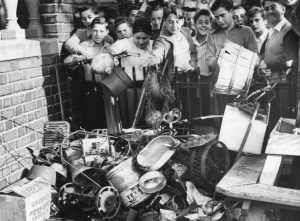
More scrap drives were organized across the country, encouraging citizens to contribute their rubber to make jeep tires, their clothing to make cleaning rags, their nylon and silk stockings to make parachutes, and their leftover cooking fat to make explosives. One of the most vital materials to collect was scrap metal. A single medium tank required 18 tons of it, and a single Navy ship hundreds more. For many people, I’m sure it looked like a great way to get rid of all those items most of us would try to unload at a garage sale.
The scrap metal drives became very competitive, almost frenzied affairs, as communities fought to out-contribute each other. Housewives threw in their aluminum pots and pans, farmers sacrificed their old tractors, and cities and towns ripped up wrought iron fences, trolley tracks and historic Civil War cannons. People were encouraged to imagine their household items being transformed into armor and weaponry for their soldiers and 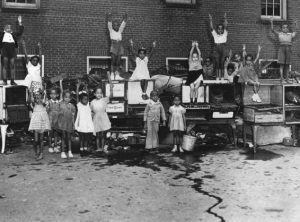 sailors in harm’s way. It was a great way to energize the Home Front. In Lubbock, Texas, a bust of Hitler was erected as a target for patriotic citizens to hurl their cookware. It was a way to take out their anger a little bit, and it worked. Walt Disney donated two iron Bambi sculptures, which were said to contain enough iron for 10,000 incendiary bombs or one 75 millimeter artillery piece. In all reality, the effect of these scrap metal drives on actual war production was very small, marginal at best. Nevertheless, their true value was in galvanizing citizen morale and a sense of patriotic unity…making everyone like they took part in the war effort. So, in the end, the scrap days did their job very well.
sailors in harm’s way. It was a great way to energize the Home Front. In Lubbock, Texas, a bust of Hitler was erected as a target for patriotic citizens to hurl their cookware. It was a way to take out their anger a little bit, and it worked. Walt Disney donated two iron Bambi sculptures, which were said to contain enough iron for 10,000 incendiary bombs or one 75 millimeter artillery piece. In all reality, the effect of these scrap metal drives on actual war production was very small, marginal at best. Nevertheless, their true value was in galvanizing citizen morale and a sense of patriotic unity…making everyone like they took part in the war effort. So, in the end, the scrap days did their job very well.
 During World War II, the Japanese had a tendency to be very sneaky. Our troops had to watch them very closely, because if they could get into a position to execute a sneak attack, they would do it. Of course, war is war, and the whole idea of war is to get the drop on the enemy, and the Japanese were quite good at it. On 28 February 1943, a convoy, comprised of eight destroyers and eight troop transports with an escort of approximately 100 fighters, set out from Simpson Harbour in Rabaul. On March 1, 1943, United States reconnaissance planes spotted the 16 Japanese ships that were en route to Lae and Salamaua in New Guinea. The Japanese were attempting to keep from losing the island and their garrisons there by sending in 7,000 reinforcements and aircraft fuel and supplies. The Japanese convoy was a result of a Japanese Imperial General Headquarters decision in December 1942 to reinforce their position in the South West Pacific.
During World War II, the Japanese had a tendency to be very sneaky. Our troops had to watch them very closely, because if they could get into a position to execute a sneak attack, they would do it. Of course, war is war, and the whole idea of war is to get the drop on the enemy, and the Japanese were quite good at it. On 28 February 1943, a convoy, comprised of eight destroyers and eight troop transports with an escort of approximately 100 fighters, set out from Simpson Harbour in Rabaul. On March 1, 1943, United States reconnaissance planes spotted the 16 Japanese ships that were en route to Lae and Salamaua in New Guinea. The Japanese were attempting to keep from losing the island and their garrisons there by sending in 7,000 reinforcements and aircraft fuel and supplies. The Japanese convoy was a result of a Japanese Imperial General Headquarters decision in December 1942 to reinforce their position in the South West Pacific.
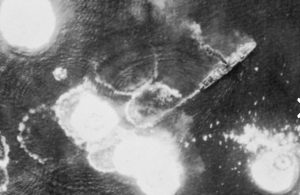 A United States bombing campaign, beginning March 2 and lasting until the March 4, consisting of 137 American bombers supported by United States and Australian fighters, destroyed eight Japanese troop transports and four Japanese destroyers. More than 3,000 Japanese troops and sailors drowned as a consequence, and the supplies sunk with their ships. Of 150 Japanese fighter planes that attempted to engage the American bombers, 102 were shot down. It was a complete and utter disaster for the Japanese. The United States 5th Air Force and the Royal Australian Air Force dropped a total of 213 tons of bombs on the Japanese convoy. The Japanese made no further attempts to reinforce Lae by ship, greatly hindering their ultimately unsuccessful efforts to stop Allied offensives in New Guinea.
A United States bombing campaign, beginning March 2 and lasting until the March 4, consisting of 137 American bombers supported by United States and Australian fighters, destroyed eight Japanese troop transports and four Japanese destroyers. More than 3,000 Japanese troops and sailors drowned as a consequence, and the supplies sunk with their ships. Of 150 Japanese fighter planes that attempted to engage the American bombers, 102 were shot down. It was a complete and utter disaster for the Japanese. The United States 5th Air Force and the Royal Australian Air Force dropped a total of 213 tons of bombs on the Japanese convoy. The Japanese made no further attempts to reinforce Lae by ship, greatly hindering their ultimately unsuccessful efforts to stop Allied offensives in New Guinea.
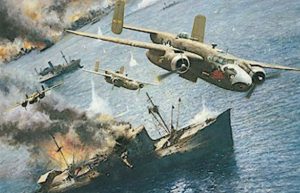
British Prime Minister Winston Churchill chose March 4, the official end of the battle, to congratulate President Franklin D. Roosevelt, since that day was also the 10th anniversary of the president’s first inauguration. “Accept my warmest congratulations on your brilliant victory in the Pacific, which fitly salutes the end of your first 10 years.” President Franklin Roosevelt was one of the very few president who held the office of president for more than two terms…an almost unheard of amount of time, and a recipe for disaster with some presidents we have had. When you think about it, however, what a great way to mark his first inauguration.
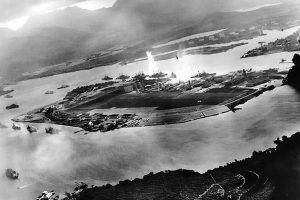
 It doesn’t matter how many years have gone by since that horrible December day 76 years ago today, I don’t think that anyone who knows anything about the attack on Pearl Harbor can forget just how horrific it was. I suppose they should have known that an attack was imminent, or at the very least suspected it. Diplomatic negotiations with Japan had broken down, and President Franklin D. Roosevelt and his advisers knew that an imminent Japanese attack was probable. Still, nothing had been done to increase security at the important naval base at Pearl Harbor. It was critical mistake that would cost a total of 2,400 Americans their lives. In addition, 1,200 were wounded, many while valiantly attempting to defend Pearl Harbor from the attack.
It doesn’t matter how many years have gone by since that horrible December day 76 years ago today, I don’t think that anyone who knows anything about the attack on Pearl Harbor can forget just how horrific it was. I suppose they should have known that an attack was imminent, or at the very least suspected it. Diplomatic negotiations with Japan had broken down, and President Franklin D. Roosevelt and his advisers knew that an imminent Japanese attack was probable. Still, nothing had been done to increase security at the important naval base at Pearl Harbor. It was critical mistake that would cost a total of 2,400 Americans their lives. In addition, 1,200 were wounded, many while valiantly attempting to defend Pearl Harbor from the attack.
It was Sunday morning, and many military personnel had been given passes to attend religious services off base. It should have been a quiet, peaceful, relaxing day. At 7:02am, two radar operators spotted large groups of aircraft in flight toward the island from the north. With a flight of B-17s expected from the United States at the time, they were told to sound no alarm. They were told wrong. At 7:55am Hawaii time, the peaceful day was shattered when, a Japanese dive bomber bearing the red symbol of the Rising Sun of Japan on its wings appeared out of the clouds above the island of Oahu. A swarm of 360 Japanese warplanes followed, descending on the United States naval base at Pearl Harbor. It was a ferocious assault. The surprise attack struck a critical blow against the United States Pacific fleet and drew the United States into World War II…like it or not. The Japanese air assault came as a devastating surprise to the naval base. Much of the Pacific fleet was rendered useless. There was simply no time to act. The window of opportunity for them to act was missed when no warning was given. Five of eight battleships, three destroyers, and seven other ships were sunk or severely damaged, and more than 200 aircraft were destroyed. Japan’s losses were some 30 planes, five midget submarines, and fewer than 100 men, and many of these were intentional suicide bombers. Fortunately for the United States, all three Pacific fleet carriers were out at sea on training maneuvers. These giant aircraft carriers would have their revenge against Japan six months later at the Battle of Midway, in a battle that would reverse the tide against the previously invincible Japanese navy in a spectacular victory.
The day after Pearl Harbor was bombed, President Roosevelt appeared before a joint session of Congress and declared, “Yesterday, December 7, 1941…a date which will live in infamy…the United States of America was suddenly and deliberately attacked by naval and air forces of the Empire of Japan.” After a brief and forceful speech, he asked Congress to approve a resolution recognizing the state of war between the United States and Japan. Finally, the president had taken action. The Senate voted for war against Japan by 82 to 0, and the House of Representatives approved the resolution by a vote of 388 to 1. The sole dissenter was Representative Jeannette Rankin of Montana, a devout pacifist who had also cast a dissenting vote against the United States 
 entrance into World War I. Three days later, Germany and Italy declared war against the United States, and the United States government responded in kind. The American contribution to the successful Allied war effort spanned four long years and cost more than 400,000 American lives. The attack on Pearl Harbor was a vicious attack that shows us that in a war, neutrality is not a guarantee of safety, but is rather viewed as a sign of weakness.
entrance into World War I. Three days later, Germany and Italy declared war against the United States, and the United States government responded in kind. The American contribution to the successful Allied war effort spanned four long years and cost more than 400,000 American lives. The attack on Pearl Harbor was a vicious attack that shows us that in a war, neutrality is not a guarantee of safety, but is rather viewed as a sign of weakness.
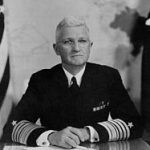
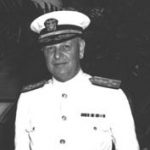 November 25, 1941, while not the date that would live in infamy, is a date that, in some ways, lives in infamy too. It was on this day that Admiral Harold R. Stark, United States Chief of Naval Operations, told Admiral Husband E. Kimmell, commander of the United States Pacific Fleet at Pearl Harbor, that both President Roosevelt and Secretary of State Cordell Hull thought that a Japanese surprise attack is a distinct possibility. It was their thought that the attack might possibly happen on the following Monday, because the Japanese were notorious for attacking without warning, President Franklin D. Roosevelt had informed his Cabinet. “We must all prepare for trouble, possibly soon,” he telegraphed British Prime Minister Winston Churchill.
November 25, 1941, while not the date that would live in infamy, is a date that, in some ways, lives in infamy too. It was on this day that Admiral Harold R. Stark, United States Chief of Naval Operations, told Admiral Husband E. Kimmell, commander of the United States Pacific Fleet at Pearl Harbor, that both President Roosevelt and Secretary of State Cordell Hull thought that a Japanese surprise attack is a distinct possibility. It was their thought that the attack might possibly happen on the following Monday, because the Japanese were notorious for attacking without warning, President Franklin D. Roosevelt had informed his Cabinet. “We must all prepare for trouble, possibly soon,” he telegraphed British Prime Minister Winston Churchill.
Kimmel’s command was at the mid-Pacific base at Oahu, which included, Pearl Harbor. At the time he received the “warning” from Stark, he was negotiating with Army Lieutenant General Walter C. Short, commander of all United States forces at Pearl Harbor, about sending United States warships out from Pearl Harbor in order to reinforce Wake and Midway Islands, along with the Philippines, which were considered possible Japanese targets. But the Army had no anti aircraft artillery to spare. War worries struck due to an intercepted Japanese diplomatic message, which gave November 25 as a deadline of sorts. If Japanese diplomacy had failed to convince the Americans to revoke the economic sanctions against Japan, “things will automatically begin to happen,” the message related. Those “things” were becoming obvious, in the form of Japanese troop movements off Formosa (Taiwan), toward Malaya. In reality, they were headed for Pearl Harbor, as was the Japanese First Air Fleet, but no one had guessed that was the intended target.
Despite the fact that so many in positions of command anticipated a Japanese attack, they had all failed to figure out that Hawaii was the target. When the attack came, they were all taken by complete and deadly surprise. Maybe they should have known, especially given the failure of diplomacy, when Japan refused United States demands to withdraw from both the Axis pact and occupied territories in China and Indochina, but no 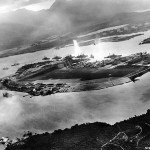
 one guessed Pearl Harbor was the target. Unfortunately they assumed Midway or Wake islands, because they seemed to be more strategic targets, and they expected that Japan would need those locations to have a chance at victory. I don’t know why the Japanese decided on Pearl Harbor, but perhaps it was a way of attacking in the heart of the United States…or as much as they felt they could. Whatever the case may be, the United States came back with a vengeance, and the Japanese would regret their attack on Pearl Harbor, because they would lose the war, date that would live in infamy…or not.
one guessed Pearl Harbor was the target. Unfortunately they assumed Midway or Wake islands, because they seemed to be more strategic targets, and they expected that Japan would need those locations to have a chance at victory. I don’t know why the Japanese decided on Pearl Harbor, but perhaps it was a way of attacking in the heart of the United States…or as much as they felt they could. Whatever the case may be, the United States came back with a vengeance, and the Japanese would regret their attack on Pearl Harbor, because they would lose the war, date that would live in infamy…or not.
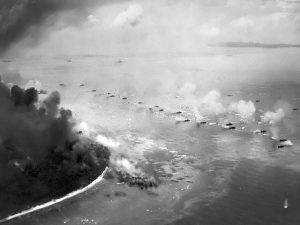 Sometimes, the best plans can have the most disastrous results, and when you find out that it was all unnecessary…it can be almost too much to bear. World War II was a difficult war. It had so many fronts and so many nations were involved. One division might invade an area with the plan of becoming a support unit for another division, who was going to be attacking another area. Such was the case on September 14, 1944, when the United States 1st Marine Division landed on the island of Peleliu, one of the Palau Islands in the Pacific, as part of a larger operation to provide support for General Douglas MacArthur, who was preparing to invade the Philippines. The Palaus Islands are a part of the Caroline Islands. It had been ordered that they be taken from Germany and given to Japan as one of the terms of the Treaty of Versailles at the close of World War I. Now, it was thought that they were needed to help with this latest invasion.
Sometimes, the best plans can have the most disastrous results, and when you find out that it was all unnecessary…it can be almost too much to bear. World War II was a difficult war. It had so many fronts and so many nations were involved. One division might invade an area with the plan of becoming a support unit for another division, who was going to be attacking another area. Such was the case on September 14, 1944, when the United States 1st Marine Division landed on the island of Peleliu, one of the Palau Islands in the Pacific, as part of a larger operation to provide support for General Douglas MacArthur, who was preparing to invade the Philippines. The Palaus Islands are a part of the Caroline Islands. It had been ordered that they be taken from Germany and given to Japan as one of the terms of the Treaty of Versailles at the close of World War I. Now, it was thought that they were needed to help with this latest invasion.
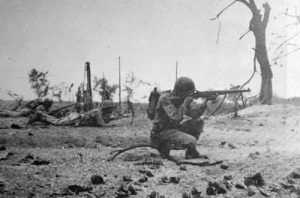 There were those who felt that this invasion was not necessary, and was in fact, dangerous. The operation was called Operation Stalemate. The problem was that the United States military was unfamiliar with the islands. That made them sitting ducks. Admiral William Halsey argued against Operation Stalemate, which included the Army invasion of Morotai in the Dutch East Indies. He believed that MacArthur would meet minimal resistance in the Philippines, making this operation unnecessary, especially given the risks involved. Going into a jungle without knowing where the enemy might be hiding is dangerous. The term, “know thine enemy” comes to mind. The Japanese were sneaky, and that would prove to be a big problem.
There were those who felt that this invasion was not necessary, and was in fact, dangerous. The operation was called Operation Stalemate. The problem was that the United States military was unfamiliar with the islands. That made them sitting ducks. Admiral William Halsey argued against Operation Stalemate, which included the Army invasion of Morotai in the Dutch East Indies. He believed that MacArthur would meet minimal resistance in the Philippines, making this operation unnecessary, especially given the risks involved. Going into a jungle without knowing where the enemy might be hiding is dangerous. The term, “know thine enemy” comes to mind. The Japanese were sneaky, and that would prove to be a big problem.
The Japanese defenders of the island were buried quite deep in the jungle, and the target intelligence given the Americans was faulty. When the division landed, the Marines met little immediate resistance, which I’m sure  gave them a sense of confidence that would very soon be destroyed. The lack of resistance was a ploy. Shortly after the Marines landed, Japanese machine guns opened fire, knocking out more than two dozen landing craft. Japanese tanks and troops followed, as the startled 1st and 5th Marine regiments fought for their lives. Jungle caves produced even more Japanese soldiers. Within one week of the invasion, the Marines lost 4,000 men. By the time it was all over, that number would surpass 9,000. The Japanese lost more than 13,000 men. Flamethrowers and bombs finally subdued the island for the Americans, but in the end, it was pointless. MacArthur invaded the Philippines without need of Army or Marine protection from either Peleliu or Morotai.
gave them a sense of confidence that would very soon be destroyed. The lack of resistance was a ploy. Shortly after the Marines landed, Japanese machine guns opened fire, knocking out more than two dozen landing craft. Japanese tanks and troops followed, as the startled 1st and 5th Marine regiments fought for their lives. Jungle caves produced even more Japanese soldiers. Within one week of the invasion, the Marines lost 4,000 men. By the time it was all over, that number would surpass 9,000. The Japanese lost more than 13,000 men. Flamethrowers and bombs finally subdued the island for the Americans, but in the end, it was pointless. MacArthur invaded the Philippines without need of Army or Marine protection from either Peleliu or Morotai.
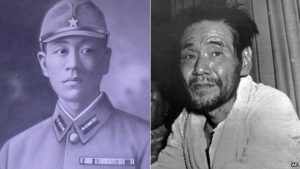 These days, lots of people have considered living off the grid. It’s almost the latest thing. Most of them really just want to do away with the bills that go along with being on the grid…water, electric, gas etc, but some of them are really wanting to lead a disconnected life. They want to shut off the phone, television, and computer, and just enjoy nature. To me, that sounds like fun for about a day…but then I am more a child of the age of technology than even my kids and grandkids are sometimes, and that’s saying something, because they are technological people, in one way or another. I have to wonder how the off the grid people would feel about it, if they had been Shoichi Yokoi.
These days, lots of people have considered living off the grid. It’s almost the latest thing. Most of them really just want to do away with the bills that go along with being on the grid…water, electric, gas etc, but some of them are really wanting to lead a disconnected life. They want to shut off the phone, television, and computer, and just enjoy nature. To me, that sounds like fun for about a day…but then I am more a child of the age of technology than even my kids and grandkids are sometimes, and that’s saying something, because they are technological people, in one way or another. I have to wonder how the off the grid people would feel about it, if they had been Shoichi Yokoi.
At this point, I’m sure that you are wondering who Shoichi Yokoi is and what was going on with him that made him such an off the grid type, so I’ll tell you. Shoichi Yokoi was a Japanese sergeant, from World War II. Shoichi was stationed on Guam, which had become a United States territory in 1898. In 1941, during World War II, the Japanese attacked Guam and captured it. The 200 square mile island, located in the western Pacific Ocean remained in Japanese Hands for three years. Then, the United States attacked and retook the island. As the Japanese forces retreated and surrendered, Yokoi made the decision not to surrender, and he went into hiding in the Jungle. He dug a tunnel, that would be his home while he was in hiding. Yokoi, who had been a tailor’s apprentice before being drafted in 1941, made clothing from the fibers of wild hibiscus plants and survived on a diet of coconuts, breadfruit, papayas, snails, eels and rats. “We Japanese soldiers were told to prefer death to the disgrace of getting captured alive.” While living in the jungle, Yokoi carved survival tools and for the next three decades waited for the return of the Japanese and his next orders…three decades!!!
Somehow, this man was so far off the grid that he had no idea what was going on in the world for almost three decades, and he assumed that World War II was still going on. He spoke to no one. He hid from anyone who might have come near him. Then, he slipped up…a good thing, as it would turn out to be. After 28 years of hiding in the jungles of Guam, local farmers discovered Shoichi Yokoi hiding in the jungle. I’m sure he was totally shocked to find out that he was the only one in the world still fighting World War II!! After he was discovered on January 24, 1972, he was finally discharged and sent home to Japan, where he was hailed as a national hero. I guess Shoichi must have grown to love Guam, because when he married, he and his new bride 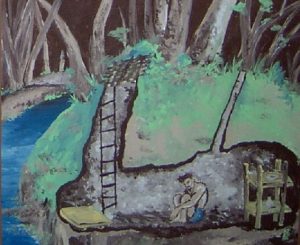
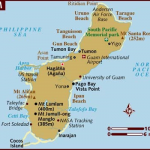 returned to Guam for their honeymoon. Shoichi went on to live a long life, and passed away on September 22, 1997 at the age of 82. The people of Guam and the governments of the United States and Japan must have though that his story was so amazing that his handcrafted survival tools and threadbare uniform are now on display in the Guam Museum in Agana. Shoichi might have been an enemy of the United States, but I can’t help but think that he must have been a very faithful soldier, to have held out that long.
returned to Guam for their honeymoon. Shoichi went on to live a long life, and passed away on September 22, 1997 at the age of 82. The people of Guam and the governments of the United States and Japan must have though that his story was so amazing that his handcrafted survival tools and threadbare uniform are now on display in the Guam Museum in Agana. Shoichi might have been an enemy of the United States, but I can’t help but think that he must have been a very faithful soldier, to have held out that long.
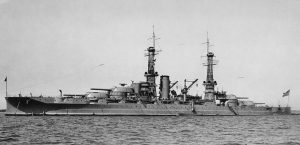 Most people know that the USS Arizona was one of the ships that was bombed when the Japanese attacked Pearl Harbor on December 7, 1941. The USS Arizona’s sinking took with it, 1,177 men…almost half of the total of 2,403 people killed at Pearl Harbor. The Arizona was one of 20 American ships and more than 300 airplanes lost that day. We know that the attack woke the sleeping giant that is the United States, and we joined World War II with the Allies to stop the tyranny that was Japan and later Germany and Italy. Most people know that the Allies were successful in World War II, and after four long years and the loss of over 400,000 lives, the war was over. There are a few facts about the USS Arizona that many people might not know, however.
Most people know that the USS Arizona was one of the ships that was bombed when the Japanese attacked Pearl Harbor on December 7, 1941. The USS Arizona’s sinking took with it, 1,177 men…almost half of the total of 2,403 people killed at Pearl Harbor. The Arizona was one of 20 American ships and more than 300 airplanes lost that day. We know that the attack woke the sleeping giant that is the United States, and we joined World War II with the Allies to stop the tyranny that was Japan and later Germany and Italy. Most people know that the Allies were successful in World War II, and after four long years and the loss of over 400,000 lives, the war was over. There are a few facts about the USS Arizona that many people might not know, however.
Twenty three sets of brothers died aboard USS Arizona. In all there were 37 confirmed pairs or trios of brothers assigned to the ship. Of the 77 men in those sets, 62 were killed. Only one full set of brothers survived. Kenneth and Russell Warriner survived because Kenneth was away at flight school in San Diego, and Russell, while badly wounded, lived. Also on board were father and son, Thomas Free and his son William who served and were killed aboard the Arizona that day. While no regulation exists, US officials discouraged siblings serving on the same ship after the Pearl Harbor attack. In addition to these men who died, the USS Arizona’s entire band, all 21 members, known as US Navy Band Unit (NBU) 22, were lost in the attack. Most of its members were up on deck preparing to play music for the daily flag raising ceremony when the attack began. They instantly moved to man their battle positions beneath the ship’s gun turret. It was the only time in American history that an entire military band died in action. In the years following the attack, and following the decision to leave the dead in the USS Arizona, it was decided that a memorial should be placed there. That is a known fact, but what I didn’t know was that in March 1961, Elvis Presley, who had recently finished a two year stint in the US Army, performed a benefit concert at 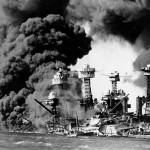
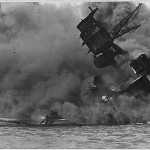 Pearl Harbor’s Block Arena that raised over $50,000. That was more than 10 percent of the USS Arizona Memorial’s final cost. The monument was officially dedicated on May 30, 1962.
Pearl Harbor’s Block Arena that raised over $50,000. That was more than 10 percent of the USS Arizona Memorial’s final cost. The monument was officially dedicated on May 30, 1962.
One of the most surprising facts about the Arizona, however, is related to the fuel. The day before the Pearl Harbor attack, the Arizona had taken on a full load of fuel…nearly 1.5 million gallons, because it was set to make a trip to the mainland later that month. When the Japanese bombers attacked, that fuel played a major part in the explosions and raging fire that followed the bombing. After the fires were put out, there were 500,000 gallons of fuel left in the ship. Now, 75 years later, the Arizona continues to spill up to 9 quarts of oil into the harbor each day. In the mid-1990s, concerns for the environment led the National Park Service to commission a series of site studies to determine the long term effects of the oil leakage. Some scientists have warned of a possible “catastrophic” eruption of oil from the wreckage, which they believe would cause extensive damage to the Hawaiian shoreline and disrupt US naval functions in the area. They continue to monitor the deterioration of the wreck site but are reluctant to perform extensive repairs or modifications due to the Arizona’s role as a “war grave.” In fact, the oil that often coats the surface of the water surrounding the ship has added an emotional gravity for many who visit the memorial and is sometimes referred to as the “tears of the Arizona” or “black tears.”
As surprising as that is, there is still one more fact that many people didn’t know. The bonds between the crewmembers of Arizona have lasted far beyond the loss of the ship on December 7, 1941. Since 1982, the US Navy has allowed survivors of USS Arizona to be interred in the ship’s wreckage upon their deaths. After a full military funeral at the Arizona memorial, the cremated remains are placed in an urn and then deposited by divers beneath one of the Arizona’s gun turrets. More than 30 Arizona crewmen who survived Pearl Harbor  have chosen the ship as their final resting place. Crewmembers who served on the ship prior to the attack may have their ashes scattered above the wreck site, and those who served on other vessels stationed at Pearl Harbor on December 7, 1941, may have their ashes scattered above their former ships. As of November 2011, only 18 of the 355 crewmen who survived the bombing of USS Arizona are known to be alive. I knew that the Pearl Harbor attack had a deep impact on the lives of the survivors, but I guess I didn’t fully understand that it was a life changing event, and it would never really leave them.
have chosen the ship as their final resting place. Crewmembers who served on the ship prior to the attack may have their ashes scattered above the wreck site, and those who served on other vessels stationed at Pearl Harbor on December 7, 1941, may have their ashes scattered above their former ships. As of November 2011, only 18 of the 355 crewmen who survived the bombing of USS Arizona are known to be alive. I knew that the Pearl Harbor attack had a deep impact on the lives of the survivors, but I guess I didn’t fully understand that it was a life changing event, and it would never really leave them.

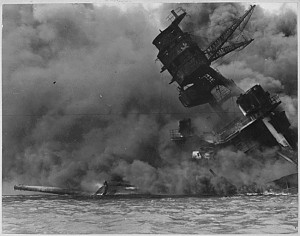 Whether people remember the date or not, I think that most people know that the attack on Pearl Harbor was what took the United States into World War II. Negotiations with Japan had broken down, and President Franklin Roosevelt and his advisors knew that in all probability, the Japanese would attack the United States. Still, nothing was done to increase security at key points, like the naval base at Pearl Harbor, Hawaii. This was especially an important base, because of it’s location. It was a place that early warning could have been given to the mainland, or where an attack could have been thwarted, but as often happens in government, the leaders don’t want to scare the nation, so they try to keep things from them…a plan the is fraught with folly. The best weapon a nation can possibly have is preparedness.
Whether people remember the date or not, I think that most people know that the attack on Pearl Harbor was what took the United States into World War II. Negotiations with Japan had broken down, and President Franklin Roosevelt and his advisors knew that in all probability, the Japanese would attack the United States. Still, nothing was done to increase security at key points, like the naval base at Pearl Harbor, Hawaii. This was especially an important base, because of it’s location. It was a place that early warning could have been given to the mainland, or where an attack could have been thwarted, but as often happens in government, the leaders don’t want to scare the nation, so they try to keep things from them…a plan the is fraught with folly. The best weapon a nation can possibly have is preparedness.
December 7, 1941 was a beautiful Sunday in Hawaii, 75 years ago today, and many military personnel had been given passes to attend church services off base. At 7:02am, two radar operators spotted large groups of aircraft in flight toward the island from the north, but with a flight of B-17s expected from the United States at the time, they were told not to sound an alarm. At 7:55am Hawaii time, a Japanese dive bomber bearing the red symbol of the Rising Sun of Japan on its wings appeared out of the clouds above the island of Oahu. Behind it came a swarm of 360 Japanese warplanes, descending on the US naval base at Pearl Harbor in a ferocious attack. The United States was unprepared, and the surprise attack struck a critical blow against the US Pacific fleet drawing the United States irrevocably into World War II.
In an attack that lasted just under two hours, the Japanese rendered much of the Pacific fleet useless, including five of eight battleships, three destroyers, and seven other ships that were sunk or severely damaged, and more than 200 aircraft that were destroyed. A total of 2,400 Americans were killed and 1,200 were wounded, many while scrambling in a valiant attempt to repulse the attack. Japan’s losses were some 30 planes, five midget submarines, and fewer than 100 men. Fortunately for the United States, all three Pacific fleet carriers were out at sea on training maneuvers. These giant aircraft carriers would exact their revenge against Japan six months later at the Battle of Midway, reversing the tide against the previously invincible Japanese navy in a spectacular victory…a beating that Japan would not forget.
The day after Pearl Harbor was bombed, President Roosevelt appeared before a joint session of Congress and declared, “Yesterday, December 7, 1941…a date which will live in infamy…the United States of America was suddenly and deliberately attacked by naval and air forces of the Empire of Japan.” After a brief and forceful speech, he asked Congress to approve a resolution recognizing the state of war between the United States and Japan. The Senate voted for war against Japan by 82 to 0, and the House of Representatives approved the resolution by a vote of 388 to 1. The sole dissenter was Representative Jeannette Rankin of Montana, a devout pacifist, who had also cast a dissenting vote against the United States entrance into World War I. Three days later, Germany and Italy declared war against the United States, and the United States government responded in kind. The American contribution to the successful Allied war effort spanned four long years and cost more than 400,000 American lives.
I have never personally been to Pearl Harbor, but I am told that the Arizona Memorial, that stands above the sunken ship, that is grave to the brave men who died inside, displays a feeling of sadness, and of being on 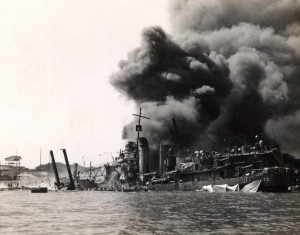
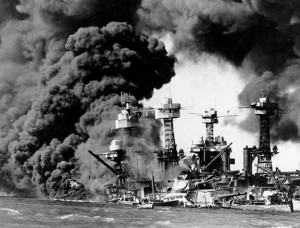 hallowed ground. It is a feeling I felt when I walked through the cemetery at Gettysburg. The men who died there…who bravely gave the ultimate sacrifice deserve the respect of those who would come to visit. I do not believe in ghosts, but I do believe that God gives cemeteries, in general, and military cemeteries especially an air of quiet honor reserved for the dead. Let us never forget that our greatest weapon in all areas of life is preparedness.
hallowed ground. It is a feeling I felt when I walked through the cemetery at Gettysburg. The men who died there…who bravely gave the ultimate sacrifice deserve the respect of those who would come to visit. I do not believe in ghosts, but I do believe that God gives cemeteries, in general, and military cemeteries especially an air of quiet honor reserved for the dead. Let us never forget that our greatest weapon in all areas of life is preparedness.
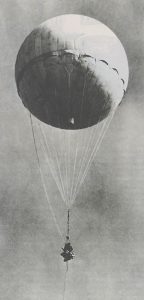 I suppose a true World War II history buff might know about some of the strange war stories there are out there, and I rather thought I was becoming a World War II history buff, but I had never heard of the Japanese Balloon Bombs. I can’t imagine how a nation could send a random bomb over another nation, not knowing where it will land, or who it will kill…but then, the evil we have seen in the 21st century has proven to be very much the same. I guess there really is nothing new under the sun. Where evil exists, horrible things happen. Such was the case with the Japanese Balloon Bombs. The Japanese were an evil nation at that time, and they didn’t care who they hurt. in 1945, a Japanese Balloon Bomb landed in rural Oregon, ad killed six people . As it turns out, these were the only World War II combat casualties within the continental 48 states. Apparently, the accuracy of the balloon bombs left something to be desired…thankfully.
I suppose a true World War II history buff might know about some of the strange war stories there are out there, and I rather thought I was becoming a World War II history buff, but I had never heard of the Japanese Balloon Bombs. I can’t imagine how a nation could send a random bomb over another nation, not knowing where it will land, or who it will kill…but then, the evil we have seen in the 21st century has proven to be very much the same. I guess there really is nothing new under the sun. Where evil exists, horrible things happen. Such was the case with the Japanese Balloon Bombs. The Japanese were an evil nation at that time, and they didn’t care who they hurt. in 1945, a Japanese Balloon Bomb landed in rural Oregon, ad killed six people . As it turns out, these were the only World War II combat casualties within the continental 48 states. Apparently, the accuracy of the balloon bombs left something to be desired…thankfully.
The idea of a balloon bomb was to send in a bomb that was silent. The problem is that balloons are hard to control. They go with the flow of the wind currents, so you don’t know where they will land. Then again, the Japanese were at war with the world, so they really didn’t care where the balloons would land. The six people who were killed by the Fu-Go or fire-balloon bomb, as they were called, were a Sunday School teacher Elyse Mitchell (and her unborn child), her 13 and 14 year old students, Jay Gifford, Edward Engen, Sherman Shoemaker, Dick Patzke, all of whom were killed instantly, when the bomb exploded. Dick Patzke’s sister, Joan was severely burned, and died moments later. The group had stopped for a moment, because Elyse Mitchell was feeling ill, and while her husband, Reverend Archie Mitchell talked with construction workers in the area, the six victims went to investigate a balloon they saw. It would prove to be a fatal mistake. The group had been going on a Saturday afternoon picnic near Klamath Falls, Oregon. They had only walked about 100 yards from the car. One of the road-crew workers, Richard Barnhouse, said “There was a terrible explosion. Twigs flew through the air, pine needles began to fall, dead branches and dust, and dead logs went up.”
Made of rubberized silk or paper, each balloon was about 33 feet in diameter. Barometer-operated valves released hydrogen if the balloon gained too much altitude or dropped sandbags if it flew too low. The balloons were filled with 19,000 cubic feet of hydrogen and the jet stream drew them eastward. They were designed to travel across the Pacific to North America, where they would drop incendiary devices or anti-personnel explosives. I would think the hydrogen alone would make a horrible bomb, but attached to the 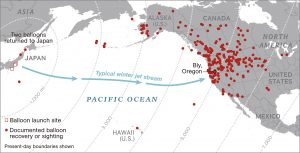 balloon was the actual bomb. The Japanese released an estimated 9,000 fire balloons during the last months of World War II. At least 342 reached the United States, with some drifting as far as Nebraska. Some were shot down. Some caused minor damage when they landed, but no injuries. One hit a power line and blacked out the nuclear-weapons plant at Hanford, Washington. But the only known casualties from the 9,000 balloons…and the only combat deaths from any cause on the U S mainland were the five kids and their Sunday school teacher going to a picnic. What a valiant victory for the Japanese that was.
balloon was the actual bomb. The Japanese released an estimated 9,000 fire balloons during the last months of World War II. At least 342 reached the United States, with some drifting as far as Nebraska. Some were shot down. Some caused minor damage when they landed, but no injuries. One hit a power line and blacked out the nuclear-weapons plant at Hanford, Washington. But the only known casualties from the 9,000 balloons…and the only combat deaths from any cause on the U S mainland were the five kids and their Sunday school teacher going to a picnic. What a valiant victory for the Japanese that was.
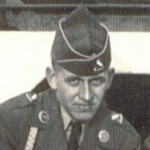 On June 25, 1950, when North Korea invaded South Korea, my uncle, Larry Byer found himself in the middle of what would become some of the hardest years of his life. Uncle Larry was an Army private during the Korean War. Korea was originally under the rule of the Japanese empire, but when it collapsed after World War II, the country was divided. The United Nations, using the United States as its main force, came to aid of South Korea. China, along with assistance from Soviet Union, came to aid of North Korea. North Korea was unhappy with the division of the country that took place after World War II. The global tensions of the Cold War that developed immediately afterwards didn’t help the situation either. Then the North Korean government decided
On June 25, 1950, when North Korea invaded South Korea, my uncle, Larry Byer found himself in the middle of what would become some of the hardest years of his life. Uncle Larry was an Army private during the Korean War. Korea was originally under the rule of the Japanese empire, but when it collapsed after World War II, the country was divided. The United Nations, using the United States as its main force, came to aid of South Korea. China, along with assistance from Soviet Union, came to aid of North Korea. North Korea was unhappy with the division of the country that took place after World War II. The global tensions of the Cold War that developed immediately afterwards didn’t help the situation either. Then the North Korean government decided  to get back the area they believed was actually theirs. In reality, Korea isn’t the only country ever to be divided, so had they simply accepted it, the problem might have been resolved right away, but they simply wouldn’t.
to get back the area they believed was actually theirs. In reality, Korea isn’t the only country ever to be divided, so had they simply accepted it, the problem might have been resolved right away, but they simply wouldn’t.
I understand why something had to be done with the country of Korea, because they had no government, but it doesn’t seem right to me to divide the country. Nevertheless, it was done that way, and in reality, that area has been volatile since that day. North Korea has tried to take over South Korea. They have also made many threats to the rest of the world. Their leader, Kim Jong-il, and now his son, Kim Jong-un, have both proven to be ruthless, and about half crazy. The rest of the world is  constantly trying to decide if we need to go in an blow them up, or try not to make them too angry. Time will tell, and it depends on Kim Jong-un.
constantly trying to decide if we need to go in an blow them up, or try not to make them too angry. Time will tell, and it depends on Kim Jong-un.
This was the world my Uncle Larry found himself in while he was a private in the Army. The North Koreans fought their battles in any underhanded way they could come up with. Their only goal was to win the war. They didn’t of course, and soon, my Uncle Larry came back home. I’m sure he was very happy to be back home. Spending any time in a crazy war like the Korean war would never be ideal in any way. I am just thankful that he made it home. Today is Uncle Larry’s birthday. He would have been 82 years old. Happy birthday in Heaven Uncle Larry. We love and miss you very much.

